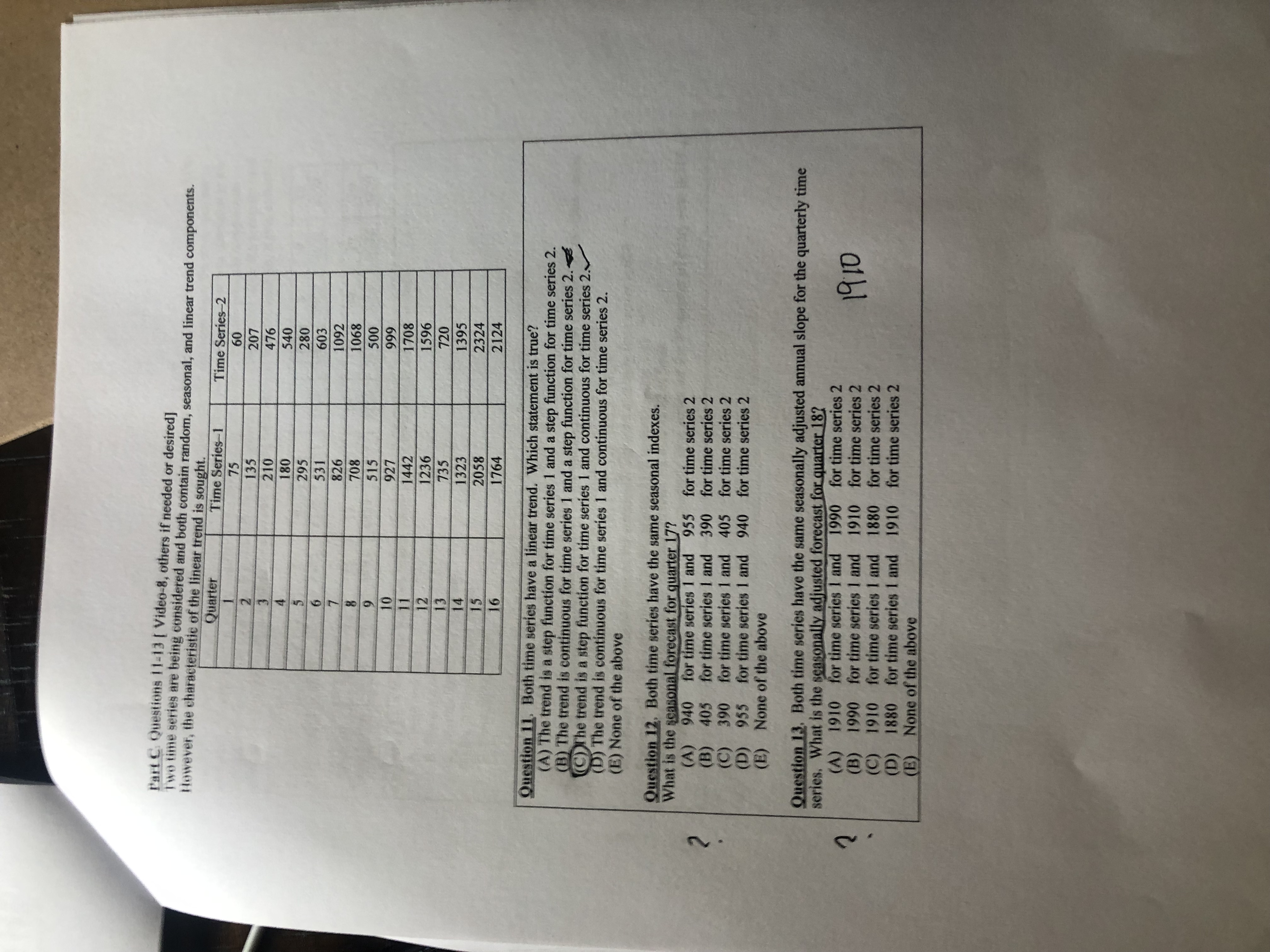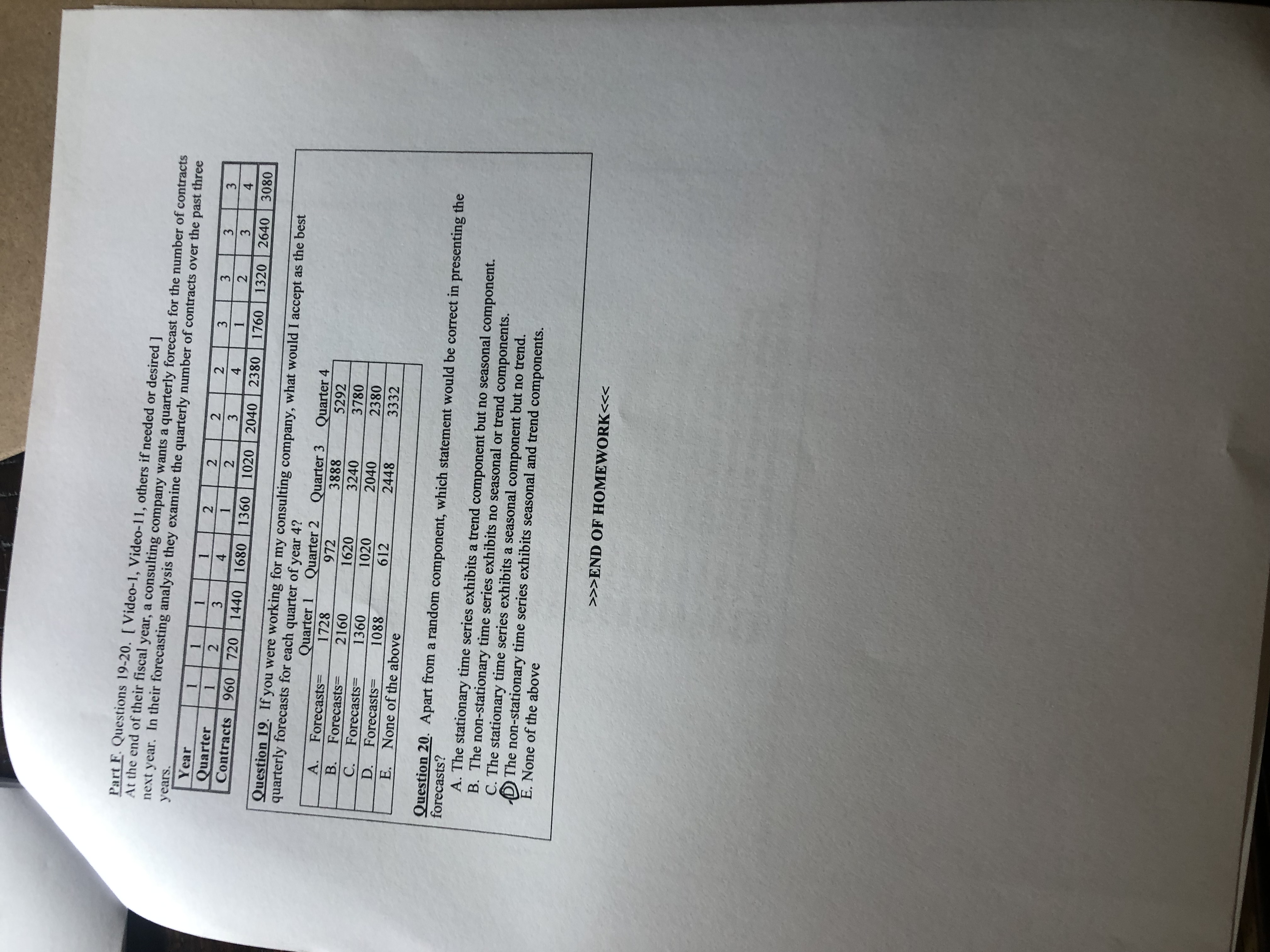Answered step by step
Verified Expert Solution
Question
1 Approved Answer
2 Part C. Questions 11-13 [ Video-8, others if needed or desired] Two time series are being considered and both contain random, seasonal, and


2 Part C. Questions 11-13 [ Video-8, others if needed or desired] Two time series are being considered and both contain random, seasonal, and linear trend components. However, the characteristic of the linear trend is sought. Quarter 1 Time Series 1 75 135 210 180 295 531 826 708 515 927 1442 1236 735 1323 2058 1764 2 3 4 5 6 7 8 9 10 11 12 13 14 15 16 Question 11. Both time series have a linear trend. Which statement is true? (A) The trend is a step function for time series 1 and a step function for time series 2. (B) The trend is continuous for time series 1 and a step function for time series 2. C)The trend is a step function for time series 1 and continuous for time series 2. (D) The trend is continuous for time series 1 and continuous for time series 2. (E) None of the above Question 12. Both time series have the same seasonal indexes. What is the seasonal forecast for quarter 17? for time series 1 and 955 390 for time series 1 and (A) 940 (B) 405 (C) 390 (D) (E) None of the above for time series 1 and 405 955 for time series 1 and 940 for time series 2 for time series 2 for time series 2 for time series 2 (A) 1910 (B) 1990 for time series 1 and for time series 1 and 1990 1910 1880 (C) 1910 for time series 1 and (D) 1880 for time series 1 and 1910 (E) None of the above Time Series-2 60 207 476 540 280 603 1092 1068 500 999 1708 1596 720 1395 2324 2124 Question 13. Both time series have the same seasonally adjusted annual slope for the quarterly time series. What is the seasonally adjusted forecast for quarter 187 1910 for time series 2 for time series 2 for time series 2 for time series 2 Part F. Questions 19-20. [Video-1, Video-11, others if needed or desired ] At the end of their fiscal year, a consulting company wants a quarterly forecast for the number of contracts next year. In their forecasting analysis they examine the quarterly number of contracts over the past three years. Year 1 1 2 Quarter 1 Contracts 960 | 720 1 3 1440 A. Forecasts= B. Forecasts= C. D. Forecasts= Forecasts= E. None of the above 1 4 1680 2 1 1360 2 2 2 3 1020 2040 2380 1760 1320 2 4 Quarter 3 3888 3240 2040 2448 3 1 Quarter 4 5292 3780 2380 3332 quarterly forecasts for each quarter of year 4? Question 19. If you were working for my consulting company, what would I accept as the best Quarter 1 1728 Quarter 2 972 2160 1620 1360 1020 1088 612 3 2 >>>END OF HOMEWORK < < < C. The stationary time series exhibits a seasonal component but no trend. The non-stationary time series exhibits seasonal and trend components. E. None of the above 3 3 forecasts? Question 20. Apart from a random component, which statement would be correct in presenting the A. The stationary time series exhibits a trend component but no seasonal component. B. The non-stationary time series exhibits no seasonal or trend components. 1320 2640 3080 3 4
Step by Step Solution
★★★★★
3.40 Rating (153 Votes )
There are 3 Steps involved in it
Step: 1
Question 11 Both time series have a linear trend Which statement is true A The trend is a step function for time ...
Get Instant Access to Expert-Tailored Solutions
See step-by-step solutions with expert insights and AI powered tools for academic success
Step: 2

Step: 3

Ace Your Homework with AI
Get the answers you need in no time with our AI-driven, step-by-step assistance
Get Started


